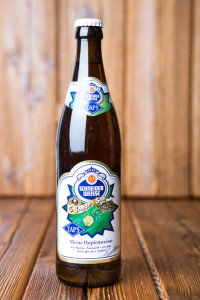 A recent Vue Weekly review (I am a bit behind due to my recent travels) looked at the Brooklyn-Schneider collaboration beer Hopfenweisse, a hopped up weizenbock. I am fairly bullish on the beer (you can read the review here). I think the traditional weizen yeast character blends well with their choice of American hop variety. The bitterness is not overdone; the beer is more about hop character rather than bitterness, which in my opinion would clash too much with the earthy, fruity yeast esters.
A recent Vue Weekly review (I am a bit behind due to my recent travels) looked at the Brooklyn-Schneider collaboration beer Hopfenweisse, a hopped up weizenbock. I am fairly bullish on the beer (you can read the review here). I think the traditional weizen yeast character blends well with their choice of American hop variety. The bitterness is not overdone; the beer is more about hop character rather than bitterness, which in my opinion would clash too much with the earthy, fruity yeast esters.
It is a worthy and notable beer from two breweries with strong reputations for quality and consistency. So, really, it is not much of a surprise that the beer works out so well. So instead of repeating my words from the column, here I want to return to a periodic topic on the website – that of hybrid styles and mixing brewing traditions. When do they work and when are they best avoided?
I am, of course, a huge fan of White IPA (evidence here) and have more recently expressed some skepticism of the naming of style-bending styles (here). In a way Brooklyn and Schneider avoid all of those debates because they, in classic German fashion, simply name the beer what it is – hop-white is the direct translation. No arguing with that.
Finally getting to my point, I ask this question. When is a hybrid style appropriate and when is it not? The short answer is easy – when the resulting beer tastes good. Well, duh! But I am asking at a more conceptual level. Certain traditions and histories lend themselves well to tweaking while others don’t. It is like the trend toward Imperializing everything. Sure an Imperial Red works for me. An Imperial Pilsner? Not so much (but that may just be my opinion). I lean towards caution when deciding to tweak or mix styles. Not all of them work, despite good intentions.
Maybe a story will clarify what I mean. A few years ago I made a brewing calculation error and added too many IBUs to my Oktoberfest. The beer turned out okay, and in fact won a specialty category medal in a competition that spring, but it never sat right with me. It tasted okay, but something seemed wrong with its overall balance. Even though I used traditional German hops, that big breadiness just didn’t sit as well with floral hop character. So while a bit of hop character accents Weizen flavours, I don’t think it worked as well with classic German malt flavours. Imagine if I had also tried to Americanize it by added some C-hops?
Again, I don’t want to sound like I am anti-experimentation. Bend those styles all you like. Just do it wisely. Respect the core aspects of each style and be sure they complement, rather than conflict. An Americanized Wee Heavy sounds just plain wrong to me, as one example.
I tip my hat to Brooklyn and Schneider for mixing brewing traditions the right way. Their combined influences created a beer that is unique, interesting yet still in sync with the underlying styles. One of the smartest things they did was opt for a weizenbock base, rather than a regular hefeweizen, which might have ended up too sharp and angular. That is the key – working out all the aspects of the beer and determining what is the appropriate flavour combination. That is the kind of mixed drink I can get into.


Leave a Reply